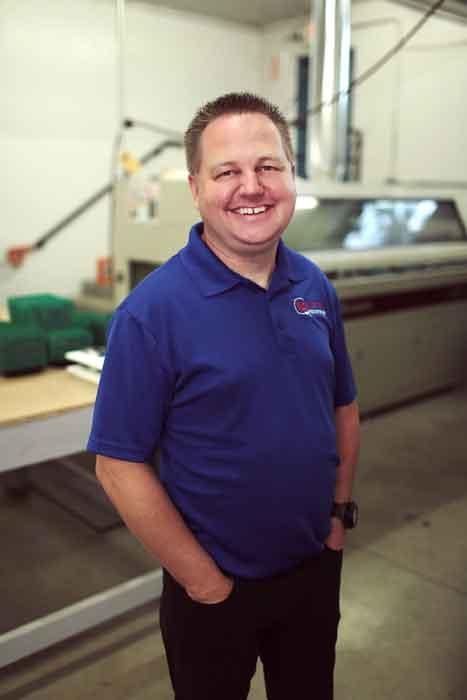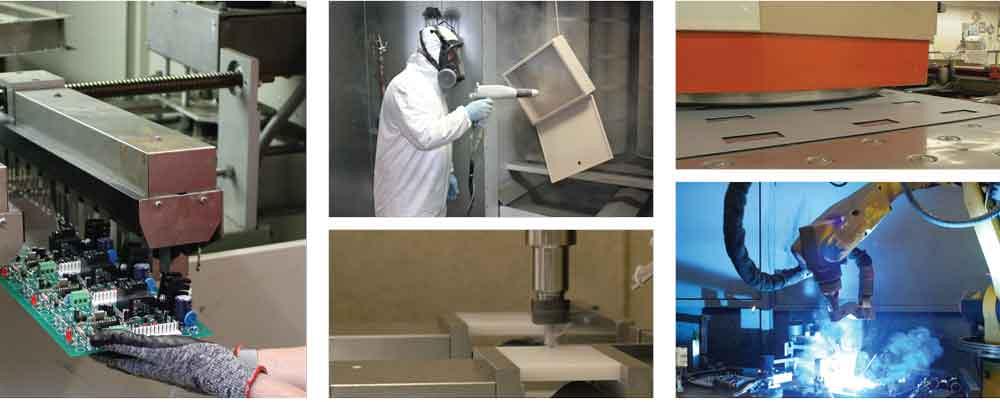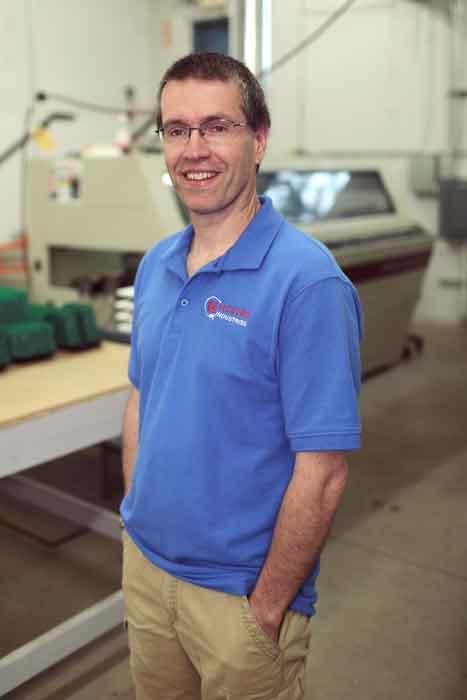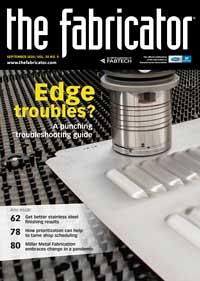Senior Editor
- FMA
- The Fabricator
- FABTECH
- Canadian Metalworking
Categories
- Additive Manufacturing
- Aluminum Welding
- Arc Welding
- Assembly and Joining
- Automation and Robotics
- Bending and Forming
- Consumables
- Cutting and Weld Prep
- Electric Vehicles
- En Español
- Finishing
- Hydroforming
- Laser Cutting
- Laser Welding
- Machining
- Manufacturing Software
- Materials Handling
- Metals/Materials
- Oxyfuel Cutting
- Plasma Cutting
- Power Tools
- Punching and Other Holemaking
- Roll Forming
- Safety
- Sawing
- Shearing
- Shop Management
- Testing and Measuring
- Tube and Pipe Fabrication
- Tube and Pipe Production
- Waterjet Cutting
Industry Directory
Webcasts
Podcasts
FAB 40
Advertise
Subscribe
Account Login
Search
One metal manufacturer’s quest to diversify revenue
Heating equipment manufacturer delves deeper into contract fabrication
- By Tim Heston
- October 2, 2020
- Article
- Shop Management

Revenue diversity builds a sustainable metal fabrication business, an ideal that heating equipment manufacturer Electro Industries continues to pursue. Getty Images
In 2013 John Seefeldt, CEO of Electro Industries in Monticello, Minn., arrived at one of his daughter’s school orchestra concerts. In the lobby he saw a fellow orchestra dad who was an engineer at a small business that made the trash compactors seen in airport terminals and shopping malls. The company had just received an order for 1,000 trash compactors, and he had no idea how his employer was going to build them all.
Seefeldt smiled. “I asked him, ‘When are you going to come up to our plant? We can show you how we can build them for you.’ And we’ve been building them ever since.”
Electro Industries is a manufacturing hybrid. Most of the company’s revenue comes from residential and commercial electric heat products such as electric boilers, makeup air units, and plenum heaters. Of course, most have highly seasonal demand, so for years the plant has been filling capacity during the slow periods with contract work.
That said, Electro Industries’ story isn’t just about a product-line manufacturer selling its excess fabrication capacity. It’s delving into contract manufacturing, focusing not on this part or that subassembly, but on the entire product, especially if it entails sheet metal, electrical components, and microprocessor controls.
Yet because the company is small—it employs about 30 people—and because its principal heating products still make up the majority of its revenue, it’s not looking to scale up its contract manufacturing into a massive operation. It can’t deliver millions, but it can, say, fulfill a PO for 1,000 trash compactors: the “happy medium” between prototyping and mass-market, high-volume production—a niche not unlike its bread-and-butter product lines.
History of Product Development
To open the door to more contract work, Electro Industries now is working toward an ISO 9001 certification. Seefeldt chuckled. “I have to admit, I thought this ISO thing was a lot more difficult, but as it turns out, we’re already doing the things we need to do to become certified. We already have the quality control procedures we’ve developed to improve our products over the years. We just need to make it official and formalize an auditing process.”
Like many fabricators, Electro Industries can punch, bend, weld, powder-coat, and assemble parts. But unlike many operations, it can also build its own through-hole circuit boards—not the surface-mount circuit boards found in most mass-produced consumer electronics, but instead the ones suited for the simpler electronics found in many products. And many of those products happen to use a lot of sheet metal.
“Through-hole circuit boards is an old technology,” Seefeldt said, “but it’s still very practical for simple control boards with capacitors and relays. Compared to surface-mounted boards, a through-hole board is much more economical. There’s still a big market for it.”
The company also has a lathe and vertical machining center that machines metal as well as plastic, usually adapting off-the-shelf plastic enclosures with cutouts and other features for its heating products.
Seefeldt’s father, Bill Seefeldt, founded Electro Industries in 1974. It started small, making one product for one customer: a makeup air heater for large agricultural facilities. Over the years he dreamed up new products and designed every piece of the assembly, from the sheet metal enclosure to the electrical relays and circuit board layouts.

CEO John Seefeldt is part of Electro Industries’ second generation of family ownership. His father, Bill Seefeldt, founded the company in 1974.
One of the company’s most innovative solutions is an air-to-water heat pump, which applies forced-air heat pump technology to water for radiant in-floor heating and other applications. “You’re taking a 100% efficient electric boiler, which we’ve been making since the 1980s, and you can throw an air-source heat pump on similar boilers, and your efficiency goes up to between 200% and 250%, even in northern climates,” Seefeldt explained. “Essentially, you can heat your house for two and a half times less money.”
No Stovepipes
Such ideas are the engines that drive the manufacturing economy, but they have plenty of curves to navigate, many of them created by the competitive marketplace and the fickle consumer. That said, many curves don’t come from market uncertainties (though COVID-19 has created plenty of those) but from inefficiencies across supply chains and the companies within them, most stemming from the age-old practice of throwing work “over the wall” to the next silo or stovepipe.
An engineer throws a drawing over the wall to a fabricator, who sees that it can’t really be manufactured. So the fabricator might suggest changes or perhaps just “throw it over the wall” again with a no-quote. Even worse, an assembler on the floor might struggle to assemble a certain wiring harness or insert certain hardware. But he’s in his stovepipe, so he stays quiet as the rework and customer returns pile up.
“We try to avoid silos,” Seefeldt said. “We just open up the communication. Our engineers and plant personnel talk. Let’s have a conversation and see what we can do.”
Company engineers talk with plant supervisors, welders, and others on the front line. “When we design something, we try to make sure we’re doing it right from the beginning,” Seefeldt said. And because so many processes are in-house, including circuit board design and assembly, a lot of manufacturing and assembly intelligence goes into the design from the get-go.
Of course, nobody’s perfect. “We’ve had times where engineers didn’t think things through and didn’t communicate their ideas to production, and by the time it got to the production floor for the prototype, we find something doesn’t fit,” Seefeldt said. “So we go back to CAD, draw it up a little differently, hand it to our head programmer in the sheet metal department, and try again. We try to avoid those mistakes, but it sometimes happens. But the great thing is we can make changes quickly, usually within a day or two. The turnaround is very quick.”
Flow and Inventory Management
In October Plant Manager Dave Hayes will celebrate 34 years at Electro Industries, and during that time he’s worn nearly every hat one can at the place. He began as an electronic technician, hand soldering through-hole circuit boards. Now he manages material flow through circuit board fabrication, sheet metal fabrication, machining, and final assembly.
The company keeps about two weeks’ worth of raw stock inventory for standard sheet metal grades and thicknesses, mainly between 10- and 26-ga. carbon steel, much of it galvanneal. Sheets flow through one of two turret punch presses that have a range of punch and form tools. Many workpieces emerge with some combination of louvers, knockouts, flanges, extrusions, and embosses.
Work then flows to the welding department, which employs welders certified to the ASME code (a necessity if you’re welding boilers). The department also has a two-station welding robot that spends most of its time welding four-sided boiler assemblies. The sheet metal then moves on to powder coating.
Circuit board fabrication requires a bit more lead time and so has a larger inventory buffer. Between three and four weeks’ worth of completed circuit boards are usually on hand.
The company has invested in a wave soldering machine, but many of the solder joints are still applied by hand. The boards also need to be masked before they undergo a varnishing process, which protects the electronics from high-moisture environments.
Regardless, circuit board manufacturing isn’t the constraint; it’s the component supply chain, which extends to Asia—an area that’s difficult to avoid for any electronics manufacturer. “You can get caught with extended lead times on a minor part,” Hayes explained, “and it can end up holding up everything,” adding that supply chain issues are the primary reason for the large inventory buffer.
Circuit boards, wire harnesses, machined plastic enclosures, and sheet metal subassemblies all meet in kits in final assembly. Assembled units are tested before they are packed and shipped.
Market Dynamics
Demand for heating products usually starts picking up in the fall and winter, for obvious reasons. During normal years Electro Industries builds ahead to meet the expected demand peak. “But of course, we aren’t building ahead this year, because we don’t know where this economy is going to go,” Seefeldt said.
He added that while orders have slumped during the COVID economy, they at least haven’t fallen off a cliff. April was very tough, as it was for many manufacturers, but orders began picking up in May and June. “In fact, we had a very good June, relatively speaking, though of course they were still down about 15% from last year.”
Demand for the company’s electric heating products usually rises and falls with the price of oil and gas, including natural gas and propane. “Back in 2014, when propane was crazy-high for a few months, we had an incredibly great year,” Seefeldt said.
As gas and heating oil become more expensive, electric heat becomes more attractive. Considering the economy and the current price of oil, one would think demand for electric heat would plummet. But over the years the company has seen demand for electric heating products decouple from the price of oil, both because of regulations as well as Electro’s evolving product offering.
Especially on the coasts, certain cities have regulations that encourage or require the use of electric heat. “We’re setting up sales channels in those markets,” Seefeldt said. “Engineers and contractors there say, ‘I can’t put in gas heat, so I need to put in electric.’ Well, you can put in ours!”
The company also has makeup air units designed to put positive air pressure back into the house when, say, a new kitchen is installed with a 1,200-CFM hood over the stove. “In all states, code requires that you have a makeup air unit that puts positive tempered air pressure back into the house,” Seefeldt said.
The company also offers those air-to-water systems that have efficiency levels that beat all heating alternatives no matter what the price of oil is. And it offers electric heating products designed to be used with dual-fuel programs, where a homeowner heats with gas during peak hours and electric during nonpeak hours (billed at a lower rate).

Electro Industries has an unusual mix of capabilities, including sheet metal fabrication, circuit board and electronics manufacturing, machining, and powder coating.
Long term Seefeldt said he sees demand for certain electric heating products increasing, though oil price will always have at least some effect on overall demand. “That said, we’re still trying to diversify and not rely solely on heating products, which is why we’re ramping up our OEM contracting.”
Refining the Revenue Mix
Attaining a diverse revenue mix is a subtle science in metal fabrication. In the custom or contract fabrication world, it’s about customer stability. How healthy are a fab shop’s customers, and how easy would it be for them to jump to a competing supplier? Deep integration (fabricating the entire product versus a tiny piece of it) makes it difficult for a customer to leave, as does an unusual mix of processes that perfectly fit the customer’s needs—like, say, having both electronics (circuit boards, wiring harnesses) and plastics and metal manufacturing under one roof.
For product lines, it’s about having demand driven by multiple factors such as the price of oil but also government regulations and the desire to save money on heating bills.
The COVID recession has revealed just how valuable revenue diversification is. As of mid-summer 2020, at least, some fabricators have reported being busier than ever thanks to being in the right markets, be it related to defense, warehousing (benefiting from the e-commerce boom), or other hot markets.
Success hinges on product quality, efficiency, and delivery, of course, but the best operation in the world can suffer if customers stop buying. Refining that revenue mix, as Electro Industries continues to do, mitigates that risk. In these tumultuous times, that is a very good thing.
About the Author

Tim Heston
2135 Point Blvd
Elgin, IL 60123
815-381-1314
Tim Heston, The Fabricator's senior editor, has covered the metal fabrication industry since 1998, starting his career at the American Welding Society's Welding Journal. Since then he has covered the full range of metal fabrication processes, from stamping, bending, and cutting to grinding and polishing. He joined The Fabricator's staff in October 2007.
subscribe now

The Fabricator is North America's leading magazine for the metal forming and fabricating industry. The magazine delivers the news, technical articles, and case histories that enable fabricators to do their jobs more efficiently. The Fabricator has served the industry since 1970.
start your free subscription- Stay connected from anywhere

Easily access valuable industry resources now with full access to the digital edition of The Fabricator.

Easily access valuable industry resources now with full access to the digital edition of The Welder.

Easily access valuable industry resources now with full access to the digital edition of The Tube and Pipe Journal.
- Podcasting
- Podcast:
- The Fabricator Podcast
- Published:
- 04/30/2024
- Running Time:
- 53:00
Seth Feldman of Iowa-based Wertzbaugher Services joins The Fabricator Podcast to offer his take as a Gen Zer...
- Industry Events
Pipe and Tube Conference
- May 21 - 22, 2024
- Omaha, NE
World-Class Roll Forming Workshop
- June 5 - 6, 2024
- Louisville, KY
Advanced Laser Application Workshop
- June 25 - 27, 2024
- Novi, MI
Precision Press Brake Certificate Course
- July 31 - August 1, 2024
- Elgin,
































